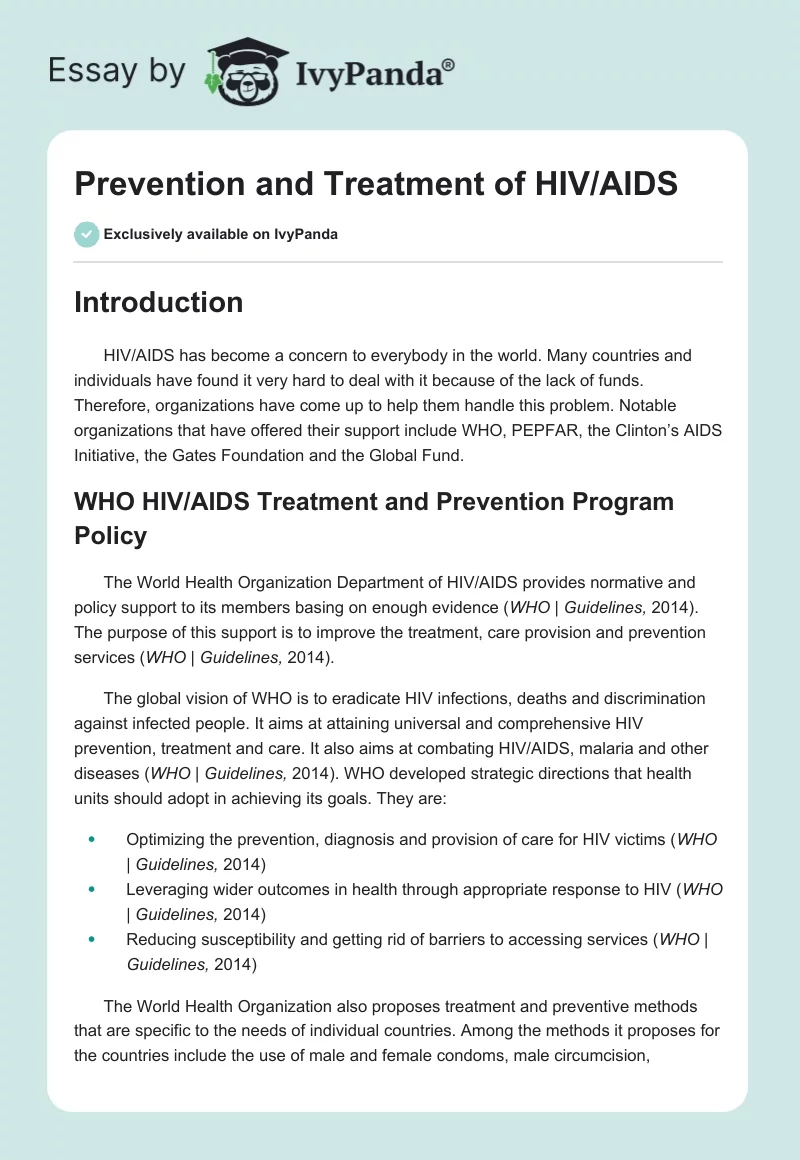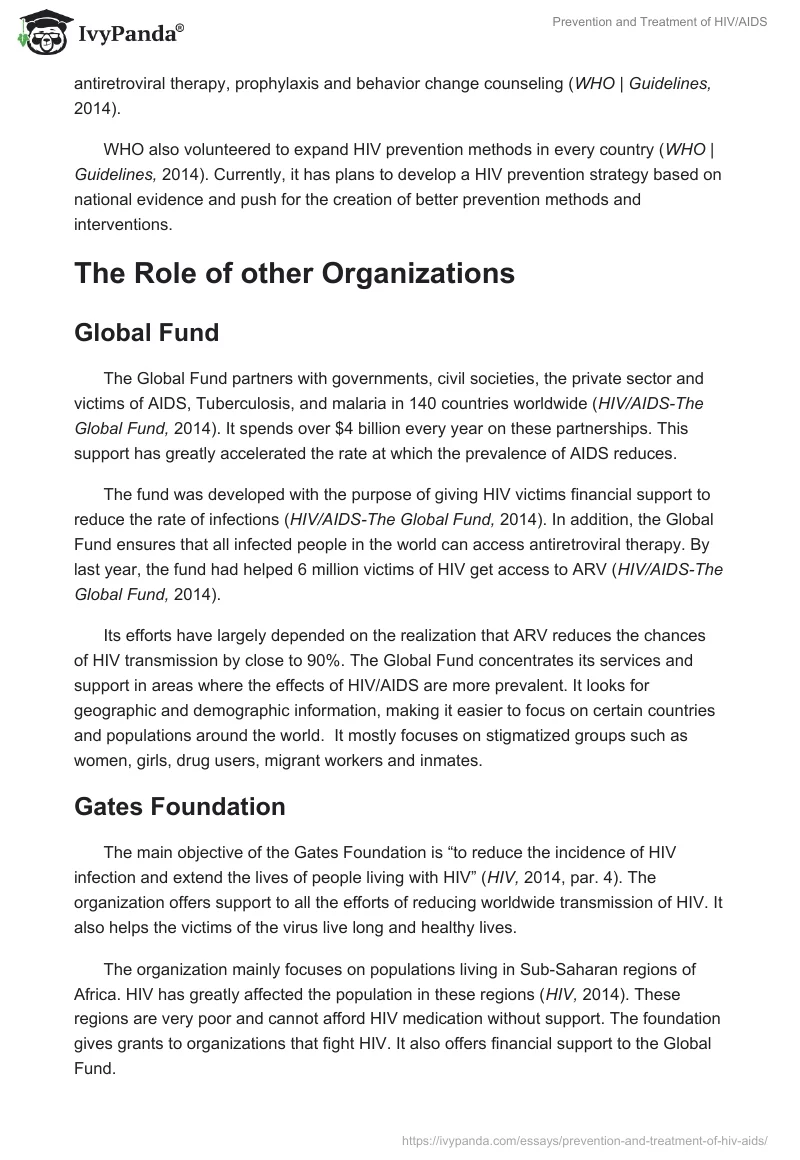Introduction
HIV/AIDS has become a concern to everybody in the world. Many countries and individuals have found it very hard to deal with it because of the lack of funds. Therefore, organizations have come up to help them handle this problem. Notable organizations that have offered their support include WHO, PEPFAR, the Clinton’s AIDS Initiative, the Gates Foundation and the Global Fund.
WHO HIV/AIDS Treatment and Prevention Program Policy
The World Health Organization Department of HIV/AIDS provides normative and policy support to its members basing on enough evidence (WHO | Guidelines, 2014). The purpose of this support is to improve the treatment, care provision and prevention services (WHO | Guidelines, 2014).
The global vision of WHO is to eradicate HIV infections, deaths and discrimination against infected people. It aims at attaining universal and comprehensive HIV prevention, treatment and care. It also aims at combating HIV/AIDS, malaria and other diseases (WHO | Guidelines, 2014). WHO developed strategic directions that health units should adopt in achieving its goals. They are:
- Optimizing the prevention, diagnosis and provision of care for HIV victims (WHO | Guidelines, 2014)
- Leveraging wider outcomes in health through appropriate response to HIV (WHO | Guidelines, 2014)
- Reducing susceptibility and getting rid of barriers to accessing services (WHO | Guidelines, 2014)
The World Health Organization also proposes treatment and preventive methods that are specific to the needs of individual countries. Among the methods it proposes for the countries include the use of male and female condoms, male circumcision, antiretroviral therapy, prophylaxis and behavior change counseling (WHO | Guidelines, 2014).
WHO also volunteered to expand HIV prevention methods in every country (WHO | Guidelines, 2014). Currently, it has plans to develop a HIV prevention strategy based on national evidence and push for the creation of better prevention methods and interventions.
The Role of other Organizations
Global Fund
The Global Fund partners with governments, civil societies, the private sector and victims of AIDS, Tuberculosis, and malaria in 140 countries worldwide (HIV/AIDS-The Global Fund, 2014). It spends over $4 billion every year on these partnerships. This support has greatly accelerated the rate at which the prevalence of AIDS reduces.
The fund was developed with the purpose of giving HIV victims financial support to reduce the rate of infections (HIV/AIDS-The Global Fund, 2014). In addition, the Global Fund ensures that all infected people in the world can access antiretroviral therapy. By last year, the fund had helped 6 million victims of HIV get access to ARV (HIV/AIDS-The Global Fund, 2014).
Its efforts have largely depended on the realization that ARV reduces the chances of HIV transmission by close to 90%. The Global Fund concentrates its services and support in areas where the effects of HIV/AIDS are more prevalent. It looks for geographic and demographic information, making it easier to focus on certain countries and populations around the world. It mostly focuses on stigmatized groups such as women, girls, drug users, migrant workers and inmates.
Gates Foundation
The main objective of the Gates Foundation is “to reduce the incidence of HIV infection and extend the lives of people living with HIV” (HIV, 2014, par. 4). The organization offers support to all the efforts of reducing worldwide transmission of HIV. It also helps the victims of the virus live long and healthy lives.
The organization mainly focuses on populations living in Sub-Saharan regions of Africa. HIV has greatly affected the population in these regions (HIV, 2014). These regions are very poor and cannot afford HIV medication without support. The foundation gives grants to organizations that fight HIV. It also offers financial support to the Global Fund.
So far, it has given approximately $2.5 billion to organizations in all countries and $1.4 billion to the Global Fund (HIV, 2014). The foundation also advocates sustainability and increase in funding programs that aim at reducing HIV/AIDS prevalence.
The fund also supports the search for a HIV vaccine. It invests in research that aims at coming up with the vaccine. It partners with private institutions, individual researchers and governments in researching on several types of possible vaccines. It also provides antiretroviral therapy and other products such as vaginal rings and injections to the victims.
In addition to other activities, the foundation provides tools for carrying out voluntary male circumcision in 14 Sub-Saharan countries (HIV, 2014). It also supports efforts by governments and other private institutions to diagnose and measure the prevalence of HIV.
Clinton’s AIDS Initiative
The Clinton Health Access Initiative was established with the purpose of helping all victims of HIV get access to medication and reduce its cost (HIV/AIDS, 2014). Since its inception, the number of people accessing HIV medication has risen from 200, 000 in 2002 to over 8 million today (HIV/AIDS, 2014).
In addition, the cost of the treatment has fallen from $ 10, 000 to approximately $100. The initiative has partnered with many countries around the world in formulating programs aimed at fighting HIV/AIDS (HIV/AIDS, 2014). The best example of such partnerships includes the partnership with Ukraine.
This partnership aimed at increasing the access to HIV/AIDS treatment. President Clinton and Preval’s agreement to expand HIV/AIDS services and strengthen health systems in Haiti and the partnership with UNITAID that focused on reducing the prices of important AIDS medicine were also part of this initiative (HIV/AIDS, 2014).
PEPFAR
The main goal of PEPFAR is to save many lives through upgrading existing strategies and supporting efforts by different countries to improve their people’s health (The U.S. President’s Emergency Plan for AIDS Relief, 2014). In 2008, the president of America signed an act that authorized the use of $ 48 billion in the fight against HIV, malaria and TB.
PEPFAR also aims at promoting sustainable AIDS eradication programs (The U.S. President’s Emergency Plan for AIDS Relief, 2014). This initiative also supports countries in responding to HIV because of the belief that fighting AIDS is more effective when countries take charge of their affairs (The U.S. President’s Emergency Plan for AIDS Relief, 2014). PEPFAR also focuses on other challenges that come with HIV/AIDS such as stigma and opportunistic diseases.
Recommendation
The organizations should provide more material support compared to money since most countries misuse the funds they receive.
Summary
Many countries in the Sub-Saharan Africa are too poor to provide good preventive and treatment methods of HIV/AIDS to their citizens. Close to 18% of their population is infected with the virus.
This situation has prompted many private and international organizations to come to their rescue. WHO, PEPFAR, the Clinton’s Organization and the Gates Foundation have provided support in these regions for a long time.
Conclusion
Private and International organizations have been very supportive in the fight against HIV/AIDS. Many countries and individuals could not afford the HIV/AIDS prevention and treatment without the support of PEPFAR, WHO, Clinton’s AIDS Initiative, Gates Foundation and other organizations. These organizations have invested lots of money and material support in regions with the most prevalent cases of HIV/AIDS.
References
HIV/AIDS (2014). Web.
HIV/AIDS – The Global Fund to Fight AIDS, Tuberculosis and Malaria (2014). Web.
HIV – Bill & Melinda Gates Foundation (2014). Web.
The U.S. President’s Emergency Plan for AIDS Relief: Five-Year Strategy (2014). Web.
WHO | Guidelines: HIV (2014). Web.


